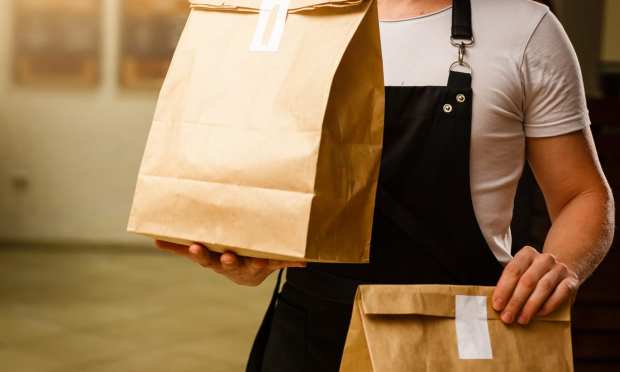Chicago-Based Restaurant Chain Bets On Future Of Delivery

Amid the pandemic, brick-and-mortar-less restaurants have rapidly grown from a relatively niche concept to a widely adopted solution to changes in the industry. Quick-service restaurant (QSR) giants like Wendy’s, Chipotle and Red Lobster have all opened new ghost kitchens in the last several months, while virtual and ghost kitchen companies have been raking in tens of millions (sometimes hundreds of millions) of dollars in funding during the COVID crisis. One company has used this turn toward digital-only restaurants to dramatically grow its national footprint while aiding struggling restaurants.
Wow Bao, an off-premises-centric Asian fusion fast food restaurant, has taken advantage of the delivery boom to supercharge its Dark Kitchen partnership program. The initiative allows restaurants to use their own facilities to make and sell Wow Bao products out the proverbial back door, retaining about 40 percent of the profits. The chain’s Asian street food offerings appear nowhere on the operator’s own menu — the Wow Bao location exists only as a menu on third-party delivery services.
“We did not build this for COVID,” Wow Bao President and CEO Geoff Alexander told PYMNTS in an interview. “But COVID exponentially grew us at a very fast rate and accelerated our growth. From April through the end of the year, we opened 150 locations across the country.”
There are several terms for restaurants that have no physical consumer-facing presence: virtual kitchens, ghost kitchens, dark kitchens. Alexander considers Wow Bao’s partnerships to be dark kitchens, which he defines as “taking an area of somebody’s restaurant that is currently dark — that they don’t need, they’re not using the space, whatever it may be” and filling that space with “another brand that they’re going to be running outside of their existing business.”
The model is especially relevant now, as on-premises dining comprises a historically small portion of the restaurant business, minimizing the need for a physical presence. A recent report on the state of the industry found that 68 percent of consumers are more likely than pre-pandemic to order takeout and that 53 percent consider takeout and delivery key to their lifestyle. According to the latest edition of the PYMNTS/Paytronix Order to Eat Tracker consumers’ use of digital channels to order their meals has skyrocketed since closures officially started shutting down in-person dining in March. Delivery services, on the whole, have grown 20 percent over the past five years, and online food delivery revenue is projected to hit $24 billion by 2023. This leaves plenty of room in the market for delivery-only kitchens such as Wow Bao’s.
The Dark Kitchen program allows restaurants to generate more revenue from their existing real estate and kitchen infrastructure. The partnership, according to Alexander, is a “proven concept that anybody can turn on with little to no capital expenditure and little to no additional equipment needed.” For a $495 initial fee, participants receive from Wow Bao online training, supply chain setup, the company’s marketing playbook, third-party setup with the company’s menu copy and photography, and some advertising. After an additional equipment cost of about $300 (if the kitchen does not already have a rice cooker and a steamer), the restaurant can begin selling Wow Bao’s menu items. Partner kitchens retain about 40 percent of each sale after food, packaging, and third-party delivery fees.
Alexander described the feedback so far from participating operators as “very positive,” saying, “I have operators that are doing anywhere from the $2,500 a week we want them to do to as much as $9,000 a week in sales.” The program appears to be performing especially well in smaller markets and at locations where operators participate in third-party promotions: “Free delivery, buy one get one 20 percent off, $5 off 20 — whatever it may be … We are seeing double-digit growth from those who run promotions, versus those who do not.”
The program is running in establishments ranging from hotels to juice bars and ice cream shops to full-service restaurants, and it has offered a boost to many small businesses struggling to make ends meet during the pandemic. “I’m very proud that we have created something that not only is growing our national footprint, but we are helping the restaurant industry,” said Alexander. “With 150 units we’ve opened, we’ve brought back farmers, we’ve brought back butchers, we’ve got distribution channels going inside the restaurants, they’ve got employees working.” This boost came at a time when the national rate of job losses was at a 50-year high and when hundreds of millions of workers worldwide were newly unemployed.
While the past year has been big for ghost kitchens, some critics have likened their success to a “house of cards” likely to topple soon. For all of their upside, some believe ghost kitchens require the rarefied environment of the COVID crisis to survive, as consumers’ preference for digital dining is likely to decrease somewhat in an environment where dining out becomes an option again. Wow Bao, however, is hopeful about the future, continuing its rapid expansion amid the vaccine rollout. By the end of 2021, the company will have 1,000 dark kitchens, according to a company news release.
There is cause for optimism—online food delivery sales are expected to grow 7.5 percent annually through 2024, according to PYMNTS’ August Mobile Order-Ahead Tracker, and recent research revealed that 23 percent of all smartphone users will tap food delivery apps by 2023.
“We believe,” said Alexander, “that we have created a market and an idea that will be available and help people for years and years to come.”
